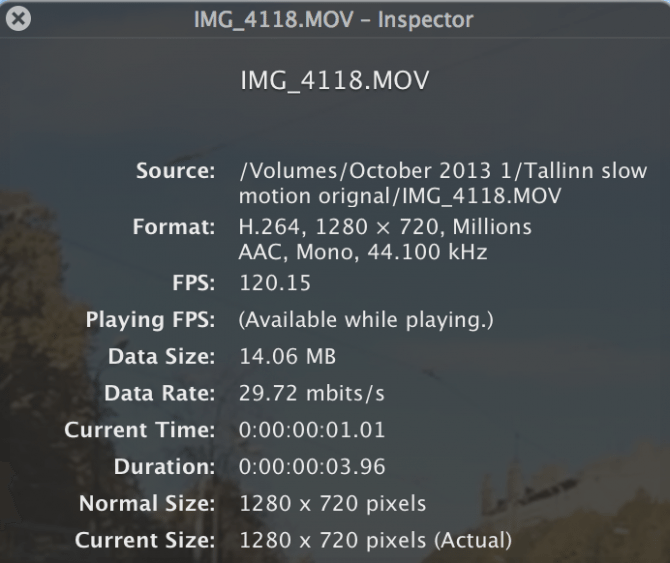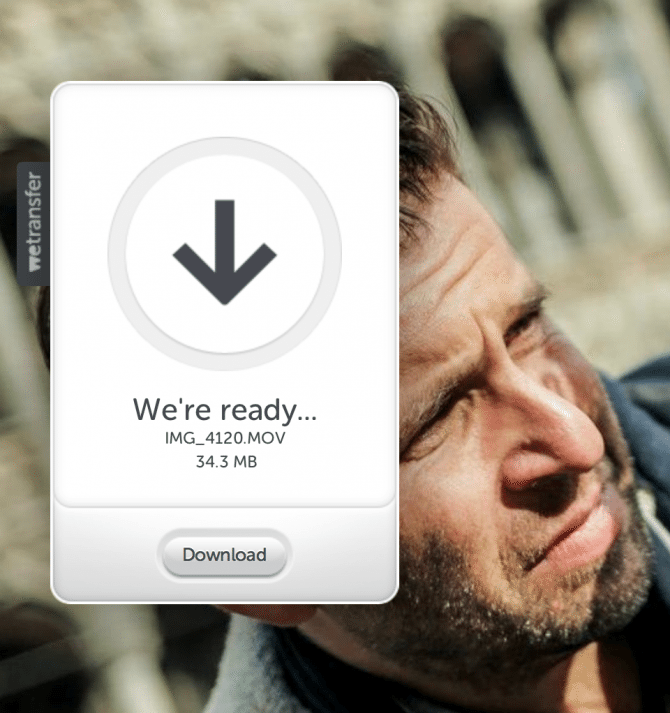Review of the iPhone 5S 120FPS super slow motion
FACT: Everything looks better in slow motion…well almost everything…gross things in slow motion look more gross! The joy of slow motion and super slow motion is that they capture something we cannot see with our own eyes (unless you are on that drug that was in the excellent Dredd movie!) This is the same reason why we find timelapse so fascinating.
My first camera to shoot slow motion properly was the Sony EX1. It could overcrank up to 60fps, which is enough, to be honest, for most things… but we always want more. We are a greedy race aren’t we? The EX1 slow motion was only 720p, but I loved it and shot a lot with it.
When the Canon 5DmkII came out, there was no slow motion on it, that was fixed with the 7D 50p/60p mode…this is not “overcranking” but recording at a higher frame rate that, when played back, looks cheap and TV like to (It’s actually 2 fps more than the 48fps Hobbit that I disliked so much). When you conformed this footage to 24 or 25p in Cinema Tools though, essentially stretching it out, you had a nice looking slow motion. The MKII remains the only Video DSLR with no slow motion ability.
We still don’t have 1080p slow motion on any Canon DSLR or even the C300/ C500/ C100. The only Canon cameras that do are my favourite, the 1DC which has 1080p 50p/ 60, also their little XA20 and XA25 that I recently reviewed.
Sony have also had 50p/60p in their DSLRs for a while. Sony are often ahead of the pack when it comes to features.
Their FS700 was the first “affordable” S35 camcorder to have a high frame rate mode. 60fps was not slow enough, enter 240fps in an 8 second burst. It could also do 480fps and 960fps albeit with a loss of quality, especially the latter frame rate. This was the dawn of affordable high-speed cameras.
Blackmagic cameras whilst high-specced don’t go over 30p at all…high speed is more useful than 4K for 99% of people! 🙂
Super slow motion (otherwise known as high frame rate) features are massively desired. Who wouldn’t want it in their cameras!?
The FS700 has recently been improved and can now can do continuous 240fps with its raw upgrade. I have a review of that coming this week, as I used it for a few days in Tuscany a fortnight back. A mixed bag really of “love the image, don’t like the system.”..but more of that in the next post. 😉
The highest frame rate camera I actually own I have had since 2008. The Casio FX1 stills camera. It could actually go up to 1200 fps in a puny 336×96 resolution! Yeah. It was not good. It did 60p OK but the other modes were not good. It’s in my house somewhere…not sure where!


Fast forward to 2010 and I was the owner of a lovely RED Epic which was capable of a maximum 300fps continuous. This was wonderful despite recording that frame rate via a crop of the S35 sensor.
To get super slow motion, many people have resorted to doing it in post with Twixtor. A lovely plug-in, but it takes a lot of work in post to make it shine. There are some tutorials on this under the Education/ Post section of my site in the top menu.
So whilst Sony has implemented HFR into some of the cameras (The F5 and F55 are capable of it, the F5 only via the raw recorder and the F55 internally and also to the raw recorder at varying frame rates) we patiently wait for Canon, Nikon and Blackmagic to give us 1080p 60p modes, let alone HFR…meanwhile a little known Californian company called Apple have gone and given us a 120fps video mode in their new iPhone 5S. Yeah it’s not a large sensor camcorder, it’s a phone (although the actual phone part is about 1% of what I use it for!) It has a tiny sensor, but it performs well, the sills are excellent too, it’s about as convenient a device you can own that can shoot in this mode.
Is it any good though? Well I upgraded my iPhone 5 to the 5s. I didn’t get in quick enough, I was one hour late after the phones went on sale online, so I had to wait until last week to get it. I only really got it for the 120fps really and because I am a gadget freak. Most of the improvements are rather incremental. I do like the finger print thingy!
Last week I was in Tallinn Estonia to teach 2 workshops on filmmaking to around 130 people. Despite having both my 1DC and F55 with me (and Movi!), I needed to take a break from shooting video and I concentrated on taking stills instead (Do check them out on Flickr, some nice ones in there, there is a link below the video) Then on my one day off I decided to shoot some 120fps with the 5S whilst walking around. I wanted it to be really simple, like most people would use the iPhone…handheld, no tripod, no rig, just in my hand, inside my bookbook cover. I wanted to see what I could do with it, or more accurately, what the 120fps video mode was capable of.
With super slow motion, you need light, you also need high shutter speed. Shooting at high shutter speed under non TV/ Film lights normally means you get nasty flicker (I will actually show you how to remove this in my next post). Luckily as we were so far North in Estonia we had some lovely low-ish sun from around 2pm which gave me some lovely light for around 4 hours. Although much of this 4 hours was spent drinking outside people watching!

So whilst walking around with my friends James, Anna and Megan, I kept stopping (much to their annoyance) to grab shots. I kept on going until sunset and until my phone filled up. I may have a 64gb one but it’s packed with apps and music; with no micro SD card slot you have to make do with your internal memory.
It looked great on the iPhone screen but is not testament to quality, you have to see it on a proper screen. Also the video recorded is only 720p…no 4K here 😉 (I still can’t believe smart phone manufacturers are boasting that their cameras will soon shoot 4K video…why?!??!)
A lovely little feature that you can do in-camera is select where you want the speed ramp once it’s been shot. It’s very slick indeed and you can take your result and share it/ bore all your friends with it on Facebook, YouTube, Vimeo etc by uploading it internally.
The phone records 30p by default and that is the result you get if you upload it to one of these services internally, as it needs a real-time timebase to show the slow motion off, but when you pull it off the phone manually it’s 120p footage and the speed ramp is gone. That’s fine. Easy to do in post!
So I took the footage into computer via USB and the built in software on my mac called image capture. Please only use the original footage for optimum quality. I then converted it to ProRes 422 and ran it through Apple’s Cinema Tools as a “batch conform” to 23.98p. This would give me the slowest looking footage and a nicer looking playback than the 30p the iPhone pumps out normally.
The downside to this is the bit rate gets reduced a lot. It records the 120fps in around 30mb/s so when you conform this to play at 24p you are getting around 7mb/s. Very low which means grading is going to be hard.


Of course by going into ProRes I wasn’t editing with a bit rate as low as that, when conformed it came out as around 38mb/s which is more respectable. It’s still not really proper 38mb/s but by converting a low bit rate to a higher bit rate, it will hold up a lot better. That’s why so many colourists I know insist on DSLR footage converted to ProRes HQ.
The results aren’t bad. Considering it’s a phone especially. They are pretty respectable. I wouldn’t call the image detailed, or sharp. It’s a bit soft really. It aliases and moires all over the place and the dynamic range is atrocious. Worst of all though it looks REALLY video-y…BUT with care in the grade, you can work with it and remove that video look. That’s why editing in camera would not be ideal. There are no colour grading apps that touch on the ones I used here.
I did initial colour correction with Red Giant’s Colorista II as usual. Changing the RGB curve, bringing the shadows up to see more detail in those seemingly lost areas, I was actually pleasantly surprised I was able find something in there. I also tweaked the green and blue curves individually and adjust highlights to make them more creamy coloured and of course to even out the exposure.
Once it was all even, I added an adjustment layer in Premiere CC and put on my good old favourite plug-in Film Convert. Using the Velvia preset on a C100 profile within the software. There is of course no iPhone profile within the software, for now, so I just went through the cameras until I found a preset I like. It happened to be that camera.
It’s the FilmConvert that really made this footage look less like video. It’s a marvelous plug-in and I cannot recommend it enough. Don’t forget the discount code for both these plug-ins below!

I got some pretty nice results. It made things a little bit more organic. I had the grain set higher than normal at 40 as it helped mask the banding of the image. Normally I keep it lower to around 22 but 40 was fine here.
The finished video worked well, the music helped of course, thank to The Music Bed again for providing an amazing library of cracking music!
So will we see loads of super slow motion video online soon? You can count on it! It’s a no-brainer. Babies in slow motion. Cats falling into the bath in slow motion. People sleeping in slow motion. Paint drying in slow motion! BUT it doesn’t have to be just home video things. With some care when shooting and perhaps using a tiny hand grip or tripod, the results could be pretty decent and you could use it for quick shots in your productions when you need a slow motion shot and don’t own a camera that does it. Just be careful of hard lines that will alias and fine patterns. Also be careful of high contrast areas like I had. It’s hard for the camera to deal with them. Hard but not impossible.
I look forward to Filmic Pro 2 being updated to give me manual control of the camera for this mode. The built-in camera app is auto exposure and the focus, although chosen by touch, changes on its own all the time. There is a lock apparently. I didn’t seem to have much luck with that! 🙂
Will it replace my FS700 and F55? I think you know the answer! But how often do I go out and about with either of those cameras in my man bag? I would need a man suit case, not a man bag!! As they say they, “the best camera high frame rate/ super slow motion camera is the one you have on you” and now I have a 120fps camera on me!
You can see the little video below. Massive thanks to my friends James Miller, his assistant Megan Clay-Jones and the lovely Anna Stocco for being willing super slow motion victims. James especially as I shot gross eating stuff with him! :0
You can also see my photos from the trip which are on Flickr shot with my Leica M and Samsung Galaxy NX below (my 35mm and medium format film photos are to come as they are not developed yet!)
It really was a wonderful trip and massive thanks to all who came to my workshops. I hope to see you again soon!
You can download a native clip using the excellent WeTransfer by clicking the image below.
I have also included some of my other slow motion videos with other cameras below this if you have not seen them!
BTS of iPhone 5s 120fps video filmed in Tallinn, Estonia from Philip Bloom extras on Vimeo.
The parents at 240 from Philip Bloom on Vimeo.
The Man, the chair & the square from Philip Bloom on Vimeo.
Postcards from the four corners: Marrakech from Philip Bloom on Vimeo.
The Bolero Toss from Philip Bloom on Vimeo.
Two Forty from Brighton: Sony FS700 from Philip Bloom on Vimeo.
Choccywoccydoodah from Philip Bloom on Vimeo.
Bangin’ n Clangin’: The Redneck Hippie from Philip Bloom on Vimeo.
Turin Brakes: Chim Chim Che-ree. RED Epic from Philip Bloom on Vimeo.
Strongman: RED Epic from Philip Bloom on Vimeo.
Evening Waltz from Philip Bloom on Vimeo.
The Tracker & The Banker from Philip Bloom on Vimeo.








26 comments
Thought you might be interested to know that the built in iPhone camera app has AF lock if you tap and hold on the foucs area you want to lock on to
http://www.imore.com/daily-tip-aeaf-lock-iphones-camera-ios-5
ah ok cool. where were you last week?!? 🙂
Great post Phillip. . Couple weeks ago I went to the lovely British coast with friends.
I took some footage and snaps on the iphone 5s as memories of the day. Not expecting to use these snapshots in any meaningful way, I was shocked when later on I saw the quality of the images on my imac. Like you, I’m not talking about resolved detail etc. but usability. I wish I’d actually bothered to take a little more care with exposure etc.. (thanks for the tip backslash!) and set to putting the clips together (out of curiosity).
Importing footage straight from phone into premiere and conforming to 23.98fps seemed to work well- even for the grade.
My experience was a bit different from yours- probably because my expectations were non-existent.
My biggest surprise was the flexibility when grading- the image held up really well and the footage showed a lot less Moire compared with Deep DOF shots from my canon rebel 720/60 mode. I managed to recover detail from highlights and shadows in a way that impressed me.
It made me think what could be possible on this little phone if i’d taken a little more care. Anyone interested here’s the vimeo link to my video.
http://vimeo.com/76352678
Ah- the British Seaside!
Hi Philip,
There’s a new report out that says that the iPhone 5s actually records the super slow-mo video at 480p and then upscales it to 720p.
http://blog.gsmarena.com/the-apple-iphone-5s-is-not-actually-recording-720p-slo-mo-video/
What’s your take on this?
quite possible. I am more interest in the image and what I can or cannot do with it. It’s certainly not full of detail but with care, like here, you can get pretty good results.
Hi Philip,
I love your grading in your latest videos/posts. Creamy-silky qualities to it. I am working hard in trying to figure out, understand and be able to apply effective grading techniques, in order to get results similar to yours (trying to mask some of the harsh codec limitations of my footage by playing with colours and grain – I use a hacked GH2 + T3i).
I couldn’t find any mention of denoising. Do you usually denoise footage before you colour correct and grade? Or do you simply bypass this process? If and when you do denoise, what application(s) have you found to be most effective, and why?
No i dont benjamin. I try to avoid it. I don’t like denoise software.
P
Great work once again, Philip. Proving once again that it is not the tool, it’s the operator.
I have just started using an iPhone 5 at 60p and it does look pretty decent, especially when combined with a Steadicam Smoothee. There are just some scenarios where these small rigs are going to work where nothing else will.
I have found myself wishing for proper manual control as well. If I knew how, I would be building some kind of bluetooth device with focus, iso, and even zoom (the digital zoom is ok too if you are shooting 1080p and putting it into a 720p project). Then I could control these features with the phone mounted on the Steadicam without having to touch it…
If wishes were horses eh…
Great review, as always but this time I could not resist the urge to correct you on one thing, because you write it so often: “It records the 120fps in around 30mb/s so when you conform this to play at 24p you are getting around 7mb/s.” You cannot make that calculation for a non-intra-only codec if you have anything but a static motive. It’s plain wrong, because the motion estimation used for P- and B-frames will work much better on slow moving subjects (and when filming in 120FPS as far as the codec is concerned, you just make the world slow down) resulting in a higher compression rate (higher quality achieved by lower bitrate). The truth in terms of quality is somewhere inbetween but likely in most cases a lot better than just dividing the bitrate by the slowdown factor.
Because I write it so often? I do? Didn’t I write it, you know, like once?
Honestly this is more or less true. IF I conformed the iphone footage to 24p without making it into ProRes, roughly what bitrate would you expect it to be then? if you could. I simply am trying to explain how weak it is. Same thing happens when I turn 50p or 60p DSLR footage into slow motion. Becomes very weak.
Fact is this. The iphone footage falls apart really badly when slowed down that is why I convert to a stronger codec before doing this. It does make a difference. How do I know? I use my own eyes! 🙂
Sorry, reading my comment again, this came across really smart-assy. Of course, you are right, that you get less quality because you reduce the bitrate and your eyes are the best measure of that. I am a big fan of your camera reviews and you made that calculation a number of times before (that’s what I meant by the clumsy “you write it so often”). My point is only that using the same camera and thus codec and filming the same subject in a higher frame rate with the same number of bytes per frame often have a very different result as far as quality is concerned because of the technical effect I described. That’s why I am questioning the rule of thumb that to me is implied by that calculation (but maybe I am the only one that perceived it that way), which is a lower bound for quality but, of course, that largely depends on the codec implementation in the respective camera. There is no doubt that using the same bitrate for 25p and 50p with the same camera, the 50p will have worse quality than the 25p but it is often a lot better than if you had filmed 25p at half the bitrate but may still be too bad for grading. I hope this explains it better.
Cheers
Great review.
I just got iPhone 5S and i love this 120fps!
I like how u grade the movie it looks fantastic!!
i have a q. How do you lock exposure and how you export your video from iPhone to other iDevice? With iMessage ?
I made 4 minutes long video(120fps) and i edited in phone iMovie but as you said no color corrections there and so on, that is why i would like to make export from iPhone!
You can watch it here http://vimeo.com/77890312
Cheers
hi
I didnt lock exposure as i didn’t know how. I do now!! hold down the screen where you want it to be and it locks.
I used image capture on the mac, built in, to bring it in.
Best
P
Camcorder++ iphone lets record slow motion directly , especially 60FPS and 120 FPS.Lets embed different speeds in same movie with music playback and need no post processing.
Check it out
https://itunes.apple.com/us/app/camcorder-pause-go-video-slow/id671882017?mt=8
Great stuff Philip, again you’ve made something that could have been quite “meh” into something interesting using a phone, a good workflow and some nice software. Thanks for sharing.
And to any of those grandstanding pixel peepers out there, pull your heads in, it is what it is!
I for one choose your blog first before other sites because it’s not your job to make it. It’s what you love to do and to me at least that always comes across to me. Please don’t be discouraged because the film community would loose a valuable resource.
thanks Samuel
Hey,
You mentioned that you a) converted the footage to ProRes and b) you knew lots of colourists that insist on converting footage to ProRes for grading as it holds up better?
Is this something you do with your DSLR footage when editing in Premiere? What did you mean when you said it ‘holds up better’?
Thanks for the help!
Jamie
is doesn’t fall apart as easily
Sorry, just because I am probably being stupid, could you please clarify what exactly “falling apart” means?
the image starts falling apart. blocky etc
I have to reply to this because, as a previous poster pointed out, this is not how digital video works. Your ProRes footage is going to be visually identical to the source footage, just a lot bigger (i.e.: a waste of space). The reason you perceave it as “holding up better” is that it is up-scaled to a higher bit-depth. Really, there is no need to do this before importing into your editing software, though. You can simply upscale it there. All the blocking artifacts from the source will still be in your ProRes footage. To get rid of those, and actually make your intermediary files worth while, you should apply a light denoiser to the footage, which will stabilize the blocks and great more robust gradients for you to color grade. You can (and probably should) also upscale the footage and correct the aliasing with something like Avisynth, because professional software is going to do that badly.
Whilst I appreciate the comment I have to completely disagree for two very strong reasons
EVery pro editor and colourist I have ever worked with insists converting DSLR footage to Prores HQ yields netter results every time
Secondly and very importantly I tried both ways here. Converted and not converted. One fell apart. The other held up to exactly the same amount of grading. I leave it to you sir to guess which was which.
Theory is fine. Reality and real life is always better 🙂
I believe that it “holds up better,” as you say. What I’m saying is that the /reason/ it holds up is just the higher bit-depth. It seems that you were implying that the cause was the higher bit/rate/, which is not the case.
Your source problems are also still there. Denoising (stabilizing) your footage first will allow it to hold up to the same amount of grading AND fix those problems. Here’s an example comparing my 7D source, heavily graded, to an 8-bit, 4:2:0 intermediary that is free of the blocking artifacts: http://screenshotcomparison.com/comparison/51777
As you can see, it holds up just fine because the source problems have been removed. It would hold up equally well at any bitrate, so long as it wasn’t severely starved.
Hi Philip,
I have just got my new iPhone 5s. When I try to record a video in slow motion the screen flickers and the video after recording as well. It only happens when I record a video in a low light (we have some LED light bulbs).
Is it normal or my iPhone’s camera has problems?
Thank you
check this out…. https://vimeo.com/80187743